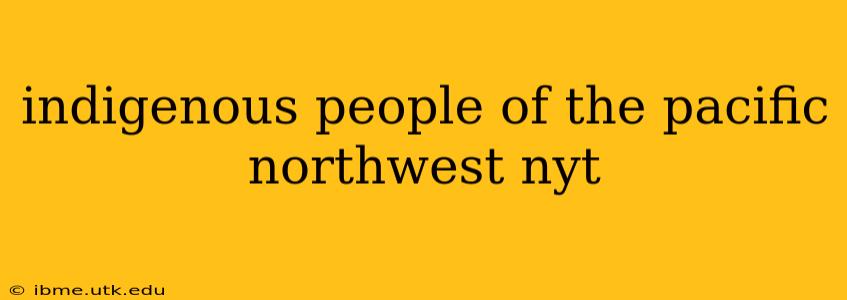The Pacific Northwest, a region encompassing parts of Washington, Oregon, Idaho, and British Columbia, is home to a diverse array of Indigenous peoples whose history and cultures are deeply intertwined with the land and sea. For millennia, these nations thrived, developing complex social structures, rich artistic traditions, and sophisticated ecological knowledge. Understanding their history is crucial to appreciating the region's vibrant past and present. This exploration delves into the lives and legacies of these remarkable people, addressing some frequently asked questions.
What tribes are indigenous to the Pacific Northwest?
The Pacific Northwest is not home to a single monolithic culture but rather a mosaic of distinct Indigenous nations, each with its own language, traditions, and territories. Prominent groups include:
-
Coast Salish: A large linguistic group inhabiting the coastal areas of Washington, Oregon, and British Columbia. Individual tribes within this group include the Lummi, Swinomish, Tulalip, Squamish, and Musqueam, among many others. Their culture is strongly influenced by the abundant marine resources of the region.
-
Chinookan: These tribes, historically located along the lower Columbia River, were known for their extensive trading networks that connected various groups along the coast. The Chinook Jargon, a trade language, was a testament to their importance in regional commerce.
-
Wakashan: This linguistic family encompasses tribes like the Nuu-chah-nulth (Nootka) and Kwakiutl (Kwakwaka'wakw) of Vancouver Island and the mainland coast of British Columbia. Known for their impressive potlatch ceremonies and intricate art forms, they adapted to the rich resources of the coastal environment.
-
Sahaptian: Inland tribes inhabiting the Columbia River Plateau, such as the Nez Perce and Umatilla, developed a culture centered around salmon fishing, hunting, and gathering. Their intricate relationship with the land was crucial to their survival.
-
Interior Salish: This group, including the Coeur d'Alene and Spokane, occupied the inland areas of the region and adapted to a more varied landscape than their coastal counterparts.
What are the traditional ways of life of Pacific Northwest indigenous people?
For centuries, the lives of Pacific Northwest Indigenous peoples revolved around a deep connection to the environment. Their sophisticated understanding of the ecosystems shaped their social structures, spiritual beliefs, and daily practices. Key aspects included:
-
Subsistence: Salmon played a vital role in their diets, supported by hunting, gathering, and, in coastal areas, whaling. These activities were often governed by intricate social protocols and spiritual practices.
-
Social Structures: Many tribes possessed complex social hierarchies, with chiefs and other leaders playing crucial roles in governance and resource management. Family and kinship ties were central to social organization.
-
Spiritual Beliefs: Animistic beliefs, ancestor veneration, and elaborate ceremonies reflected a deep connection to the natural world. Potlatches, ceremonial feasts often involving the gifting of elaborate items, were critical social and spiritual events for many coastal tribes.
-
Art & Crafts: The region boasts a rich artistic tradition, featuring intricately carved totem poles, masks, and other ceremonial objects. These artworks served both spiritual and social functions.
What were the impacts of European colonization on the indigenous peoples of the Pacific Northwest?
The arrival of European colonizers had a devastating impact on the Indigenous peoples of the Pacific Northwest. Disease, displacement, and the destruction of traditional ways of life led to significant population decline and cultural disruption. Key aspects include:
-
Disease: Introduced diseases like smallpox decimated populations, often without the Indigenous peoples having any immunity.
-
Land Dispossession: Treaties were often broken, and Indigenous peoples were forcibly removed from their ancestral lands. This loss of territory profoundly affected their livelihoods and cultural practices.
-
Assimilation Policies: Government policies aimed at assimilating Indigenous children into European society through residential schools inflicted lasting trauma and contributed to the erosion of traditional languages and cultures.
-
Resource Exploitation: The exploitation of natural resources, particularly timber and fisheries, further disrupted Indigenous communities and their traditional practices.
What is the current status of indigenous peoples in the Pacific Northwest today?
Today, Indigenous peoples of the Pacific Northwest are actively working to revitalize their languages, traditions, and cultures. They are engaged in self-governance, economic development, and environmental protection efforts. Many tribes operate casinos and other businesses, providing economic opportunities for their members. However, challenges remain, including poverty, health disparities, and the ongoing effects of colonization. The fight for land rights, cultural preservation, and self-determination continues.
How can I learn more about the indigenous peoples of the Pacific Northwest?
There are many resources available to learn more about the Indigenous peoples of the Pacific Northwest. Visiting tribal museums and cultural centers, attending events and ceremonies (with appropriate respect and awareness), and supporting Indigenous-led organizations are all important ways to engage with and learn from these communities. Academic research, books, documentaries, and online resources offer further opportunities for education and understanding. Remember always to approach the subject with sensitivity and respect, acknowledging the lasting impacts of colonization and the ongoing work of Indigenous communities to reclaim their histories and futures.
